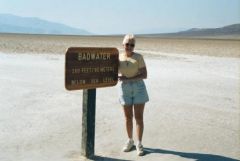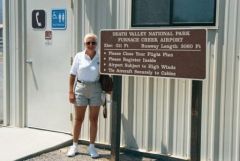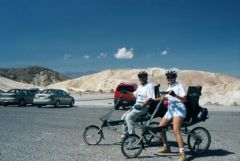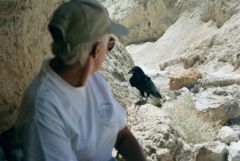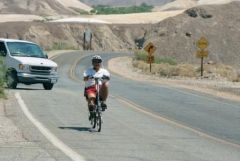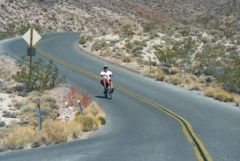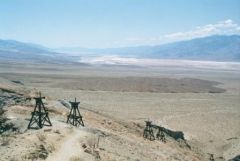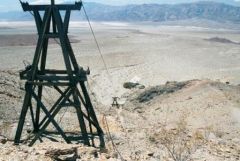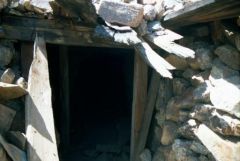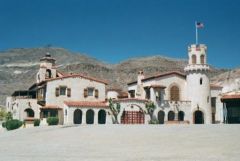-
Content Count
2713 -
Joined
-
Last visited
-
Days Won
44
Content Type
Profiles
Forums
Blogs
Gallery
Everything posted by tbutler
-
All right John and Therese, you started it! For Mexican food in Mission, try Danny's Restaurant (there are at least 3 of these in the RGV but we like the one on 11th and Dunlop in Mission). If you want Mexican food in Mexico, El Johnny in Carmargo. For Mexican food and dancing in Mexico we prefer Arribas in Progresso. If you want Texas BBQ, we like Fat Daddy's on FM1015 just south of Weslaco or Willies (It ain't fancy but it's good) in Alamo and Edinburg. If its steak you fancy, well, it's Texas. You pretty much can't miss. We enjoy Republic of the Rio Grande on 10th Street in McAllen for fine dining. And these are just a few of the 100's of restaurants in the US 83 corridor along the Mexican Border. There are all the usual chain restaurants and many specialty restaurants. You'll find many that suit your style, whatever style that is!!!
-
Yes, should have been the Officer Basic Course, I forget terms after so long! Can't even remember the exact MOS. Yes, it was Medical Service Corps. Good of you not to hold it against me! Tom
-
A really nice piece! Well said. Many people wouldn't understand a home that isn't a permanent location. Thanks for saying it so well.
-
Richard, Yes, Monaco went bankrupt. The remains of the company have been purchased by Navistar (International Trucks) and is back up and running. The company that remains will restructure and consolidate the line of coaches. Eventually it is expected they will change to using the Navistar engines instead of Cummins. Some suppliers are still negotiating with Monaco - Navistar so replacement parts for older models may not be available soon if ever. The old Monaco was always strong in standing behind their coaches. While it has no legal obligation to do so, it is expected that Navistar will continue this tradition with the new coaches while doing what it can for the older coaches (keeping the parts supply alive and providing technical support). Warranty issues with the pre-bankrupcy coaches are a lost cause other than parts warrantied by a third party manufacturer. One of the strengths of the Monaco product was the custom designed frame and the eight (ten on tag axle models) airbags and similar number of shock absorbers with the airbags and shock absorbers being mounted in line with the outside tires. Regarding the exhaust brake or engine brake, the latter is much more effective. You may find a retarder on bus conversions, this works within the transmission, it is more expensive but much more effective than either the exhaust brake or engine brake. There is a detailed discussion of these three devices elsewhere on the forum Exhaust Brake or Engine Brake.
-

License For Motorhome Over 26,000 pounds
tbutler replied to JohnandKris's topic in Laws and Legislative Action
Have your husband take the tests and get his opinion. The best answer to your questions will come from the license bureau personnel at the location where you will take the tests. I think you'll have a written test as well as a driving test. I've heard of driving tests with RV's being given in cities or towns and also tests that were primarily on the highway. There will be a test preparation booklet that you should get in your hands right away. It will guide you through the study you need to do to pass the test. Again, see the license bureau personnel to get this book. I have one for my home state even though I don't need the advanced license. I figure it is useful knowledge or they wouldn't require it, even if only for commercial drivers. -
How about a snake? They are easy to care for, only need a small light or heated rock to keep them warm. They don't eat much and you don't have to take them for a walk. Be sure the cage is snug, too many places to hide in a motor home! Get one that eats mice (not all snakes do) and you'll have a ready supply of food at pet stores if not in your campground! Actually, most snake owners prefer the disease free pet store mice to wild mice! A small lizard or a turtle would be a similar pet. Another pet that doesn't take up much room and is low maintenance is a tarantula. My grandson has an insect zoo. A couple of giant preying mantis are his favorites. If you had a couple of small insect cages, he could search out and find his pet on the trip! He could have a series of pets if your son practiced catch and release over time. You could use internet resources or local naturalists to identify mystery insects. In the process your son would be learning about living things that aren't furry and cute! There is always the pet rock! They don't make much noise at night and you don't have to worry about the heat or cold. This could also be found along the way as you travel. Just don't take it from a state or national park! I've had all the above as pets either in my science classroom or my own home in the past. They are all great pets.
-
I did my officer basic training at Fort Sam Houston in 1969! Many fond memories of the post and our stay in San Antonio. The River Walk wasn't as fancy then as it is today. We watched many a parade in downtown San Antonio, unlike any parades we'd seen in St. Louis, MO. All the high school ROTC units marching in the parades were most impressive. We still love to get to San Antonio when we can. If we head that way, I'll check to see if you are still there. Perhaps we can get together. Tom
-
The owners of "snootie" parks are well compensated by those who stay in their park to be as snootie as they are. When fewer people are inclined to separate themselves from the rest of the rabble, they will change their ways. In the meantime, do you really want such snootie people for neighbors? I'd rather live among people who are more interested in who you are than how much money you have and what you own. Many parks have rules about the condition of the living units (trailers, motor homes, mobile homes) that do not specify the age as a criteria. This allows them to remove the derelict units which do eventually make a camp look unacceptably humble. For those who can't comply there are many campgrounds without such restrictions. We just spent a month in a campground that I noticed has gone downhill pretty fast in the last two years. I suspect this is a result of the current economic conditions. There is a balance to be struck, trying to keep the property campground owners own from becoming so shoddy that they can't recover their investment and becoming so exclusive that no one can afford to stay at their facilities. In the park where we stay now, there is a very old motor home. I was startled last year to hear the diesel engine running! It turns out he park had instituted a requirement that all vehicles be licensed so they had to get the motor home started and take it out for inspection which it then passed. They spent several thousand dollars to get it up and running and inspected again so they get to stay. Another unit was hauled out because the owners couldn't or wouldn't comply with the rules. So I guess I'm living in a "snootie" park at least to some degree.
-
We haven't been there yet but its on our list. One of the overlooked groups of women who served during WWII were the WASPs. The Women's Airforce Service Pilots. They were never given military status and were dismissed at the end of the war. They never received any military benefits or recognition yet their service to the country was immeasurable. They didn't serve in combat, but they freed many pilots to serve instead of doing the routine flying they were assigned. These women flew almost every combat plane produced during WWII from the factory to their assigned units. Many of these flights were overseas. They flew the fighters, bombers and transports that the male pilots flew in combat. These brave women flew over 100,000 of these planes on their first extended flights, making them test pilots though they weren't called that. I'll be looking for some recognition of their contribution at the memorial. These were women who helped break down the barriers for the women who serve today. Thanks for the note Capt. Cathe and thanks for your service.
-
There are a lot of things to consider when purchasing any coach. There are books published on the subject and organizations devoted to educating the RV consumer. I'd advise that you do some checking on the web looking for some of that information. For full timers, there is the storage space, convenience of operation of utilities, comfort of ride, fuel economy, kitchen space, adequate heating and cooling for the areas you plan to frequent. Does the unit fit the kind of travel you want to do? A friend of ours bought a Class A but couldn't get it into the state and national parks they wanted to visit so they sold it and went to a pick-up camper. That has been sold because they couldn't stand the rough ride. Now they have a Class C. They aren't full timers but they have been through the whole range of RV's trying to find something that fits their camping style. So many factors such as the amount of ventilation available (I like big windows with screens for ventilation), the steps, how difficult will it be to get the groceries into the rig after each shopping trip? Are the headlights bright enough for night driving if/when you have to drive after dark? How does the motor home turn. Is the rear end so long that it swings wide when you turn. If it is, you might knock over a few picnic tables when you pull out of sites! What is the useful load of the motor home? After fuel, propane and fresh water tanks are full, how much weight is left for what you plan to take with you. For full timers, there should be 3000 to 5000 pounds of carrying capacity beyond the full fuel and water tanks. Anything less than 3000 could result in an overloaded (and dangerous) coach unless you are a really light packer and resolved not to load up on any extra materials as you live in your coach. Can you see the TV comfortably? Is the bed comfortable? How quiet is it inside the unit at night when parked near a highway? Don't laugh, lots of campgrounds are right next to the railroad tracks! Will the unit handle the weight of the toad you have or plan to have? Check the weight rating of the hitch and the Gross Combined Vehicle Weight Rating. Will the weight distribution work? Some coaches have fuel, water and waste tanks located such that significant weight shifts can occur as fuel, water, wastes are added or removed. Notice, I'm asking lots of questions. These are just a sampling of the things you need to measure any coach you think you might want to buy. Neither you nor I can think of all this stuff so that is why I suggest you consult some of the resources available in book stores and on the web to help you analyze your possible purchases. Remember, you're looking at a very large purchase. Take you time and consider all the possibilities. Enjoy the journey, welcome to FMCA and welcome to another full timer!
-
Well, WG, you gave us plenty of what you like and don't like. I can address some of this, others will fill in more. First, our experience in Texas is based on over eight winters (we're into the first week of our 9th winter) in the state. Yes, it can be windy but not consistently. We've had winters when the wind blows 25 mph every time we play golf or tennis and other winters when the wind seldom blows. We've seen wet winters and dry winters, warm winters (last year) and cold winters. We winter in the Rio Grande Valley (RGV) so when I say cold winters I'm talking temperatures in the low 40's or even into the 30's at night and daytime temperatures that don't get out of the 50's. The longest I've seen a stretch of weather that cold is in the range of a week. These cold temperatures are usually confined pretty much to the months of December and January. The further south you get, the nicer the weather becomes. In and around Houston you'll be guaranteed rainy weather and plenty of cool temperatures. In the RGV you will be a long days drive from Houston. Texas is a very big state! We've spent time around San Antonio. It is beautiful country but you can subtract 10 degrees from the temperatures above. North of San Antonio around Boerne and New Braunfels you'll find communities with a strong German heritage. We've camped on the coast in Corpus Christi. There are great fishing opportunities and numerous parks for hiking and birding. Corpus Christi has excellent big city resources, movies, bowling, festivals, restaurants, etc. You can add 10 mph to the wind factor above if you camp on the coast. South Padre Island has a state park with RV Camping. We even see people with their RV's parked right on the beach (That's not for me!). I'm not sure about the rates but the campsites in the State Park are right near the beach. Just outside the state park is Dirty Al's Seafood Restaurant for great inexpensive seafood. Temperatures are cooler on the coast most times during the winter. As I write this the temperature is 82 degrees and that is the forecast for the high temperature for the rest of the week here in the RGV. just checked and the temperature on South Padre is 71 degrees right now. There are literally hundreds of RV Parks here in the RGV and all along the TX coast as far as that goes. You'll find parks with huge dance halls and regular dances and parks located next to bird sanctuaries that offer convenience for the many birders who come to the RGV and the Texas coast each year. Some parks have 200 campsites, some have 20. There are parks on golf courses and parks under highway bridges - but they are close to shopping!!! Most every park has carry in dinners regularly, nobody starves here! There is usually a happy hour group or two within a park. Sometimes it's just you and a neighbor or two, sometimes it's a group of 20 or 30 in a big campfire circle. We take trips to Mexico to eat, shop, bicycle ride, or tour in buses. If you want you can learn to speak the local Mexican dialect of Spanish. There are an abundance of volunteer possibilities in communities, schools, parks, etc. Many campgrounds have positions for work campers who may spend a couple of days a week working in the campground to help defray the cost of their fees for camping. By the way, there is a paper published here in the RGV called "The Winter Texan." It lists activities going on at parks all over the valley as well as other shows and events. You can go to dances, dinners and other events in parks other than where you are staying. We're all one big family! The natives here are friendly. They don't resent our presence like you will find in some parts of the country. We are known as "Winter Texans." There are special sale days for Winter Texans. There are whole sets of activities aimed at the senior citizens who arrive in the RGV every fall to spend the winter. There are also plenty of community activities year round and we're welcome to join in those activities as well. San Antonio in the spring has a parade just about every other week. South Padre Island has a convention center with regular shows. McAllen also has a convention center and an arena where you can see big performers or the local symphony orchestra. You'll find parks that have everything you could want, concrete pads, sheds for storing your goods, high end wi-fi, etc. Cell service has been excellent in most places we've stayed. I've also seen parks where the roads were dirt, mud when it rains. Rates are lower here than in Florida for similar parks. Many parks here have seasonal rates which can save quite a bit of money for you. Some parks have annual sites at a rate that makes it very attractive to pay for the site for the year and then know that you can come and go as you please and have the same spot always ready for you. In our park once you take an annual on a site, you can make improvements like a concrete pad, shed, etc. When you decide to leave the park, you can sell those improvements to anyone who wants to take your site. We pay about $2200 a year for an annual on a site that is 30 x 55 feet. We're in a quiet area where the noisiest people around are usually glad to turn down the guitar if asked! There is that darned rooster at a neighboring residence that insists on crowing well before sunrise! Most of the parks here in the RGV have some permanent residents and there are many that are mixed mobile home and RV parks. In our park, older mobiles are moved out and there are requirements for keeping sites neat and well taken care of. Most parks have an activity director who organizes trips, games from shuffleboard to softball. You can find most any card game you want to play and you'll find somebody who shares your interest in whatever you might be interested in. Our park has a large group of motor cycle enthusiasts. They go out for rides, long and short, when the weather is good. Sometimes in groups of two or three sometimes in a group of 20. There are tournaments within parks and between parks. If you come, I'd advise staying for a short time in a park in an area you are interested in. Then spend some of that time touring other parks to see what they offer. If the area isn't to your liking, move on to another type area and spend a week or two exploring the parks in that area. I can almost guarantee that you'll find something that suits you here in Texas. There are so many parks here that I couldn't possibly give you a recommendation for one or another. Come on down to Texas for some BBQ some great Mexican food and some Winter Texan fun! Disclaimer: I do not work for the Texas Tourism Commission or the Chamber of Commerce. This is a totally uncompensated testimonial. If my advice is good, you can send Seajay 10 cents!
-
Most of you are used to hearing from my husband, Tom, but he asked me to respond to this one. I have cooked several turkey dinners in our Monaco. All of them have turned out better than the first Thanksgiving dinner I cooked as a newlywed (totally unaware that you were supposed to discover and remove a paper packet of giblets in the bird's neck cavity!!!). I have cooked both whole turkeys (10 pounders) and turkey breasts in my convection oven. They come out very well and you cook them exactly the same way you would in a regular oven. The hard part is finding enough burner space to cook the many other dishes that go with Thanksgiving dinner. The pie can be made the day before (if you can keep your husband away from it over night), and I substitute bread made in the bread-maker for baked dinner rolls. My stuffing goes in the bird, which means I can use my two burner stove top for potatoes and a vegetable. Cold things can be made ahead of time and stored in the refrigerator and, after all, what is Thanksgiving dinner without a jello mold that is forgotten in the 'fridge until after the meal? Our first Thanksgiving dinner on the road was a pure joy. It was just the two of us in a lovely rural setting, a bottle of good wine and much to be thankful for. Enjoy!
-
Jim, Have you tried to get an owners manual for your Dynasty? We had a '94 Dynasty 38' and it had the info in the book, did they leave it out of your book or don't you have a manual? You might want to check into the Monacoers web site on Yahoo. There are a lot of technical gurus on the site and many have older coaches. http://autos.groups.yahoo.com/group/Monacoers/ will get you there. After you register, search the past discussion to see if there is any relevant information before posting. These guys are friendly and will gladly help if they have the info. Some of them are former Monaco employees, some are engineers and mechanic owners, a few are all BS, an interesting group.
-
One of the things that impressed me recently when looking at the Prevost vs. the manufactured units was the difference in "livability." Our mid-line Windsor has more pantry, closet and drawer space than any Prevost coach we looked at. The Prevost are glitzy and have a tremendous "Wow" factor, but they wouldn't work for us as full-timers. They are much more durable, heavy duty frame, etc. You can customize them to be what you want but you're paying a tremendous price for that if you are looking for a full timers coach. Consider what your needs are. Are you looking for a glitzy party coach or do you want a "working" coach? You don't need a working kitchen and pantry if you are going to eat every meal out. If your trips are weekend trips and tailgating, you don't need large closets or drawers. Are you going to drive 300,000 miles with your coach? At 15,000 miles a year, our average travel, that would be 20 years of travel and I think I can get that our of our coach easily. I don't need a coach that goes 1,000,000 miles! I would love to be driving a coach with a tag axle and an extra 5 feet and a second bathroom (not even a bus) but the fuel mileage goes down to 4 or 5 MPG. Can you afford that? If you can, go for it. For me, it would be the straw that breaks the camels back. I couldn't keep traveling the way I want at the fuel prices today.
-
The only comment I can make here is that if your tires are near their capacity, you will have them inflated to near the maximum allowed and they'll likely be pretty stiff at that point. If your tires are rated for more weight than you are carrying, then you inflate them to carry the load which is less than maximum inflation. That should give you a softer ride. What inflation pressure do you have to put in each tire to carry the load and is that practical for your equipment? I have to work hard to get 110 pounds into my tires using my engine air compressor. I recently inflated my front tires to 114 pounds in the evening so they would be a 111 pounds then next morning when we departed (a cold morning). I wouldn't want to have tires that I had to inflate to 120 pounds to get the weight carrying capacity that I needed. I would have to inflate the tires at a truck stop if I needed 120 pounds pressure and that is not convenient at all. Not only is it not convenient, if you are driving to the truck stop to inflate the tires, they will be hot and when they cool, the pressure will drop significantly. The only way I would inflate tires at a truck stop is if I had a tire that was low and I wanted to get to a repair shop with that tire. The maximum pressure for my tires is 120 pounds and the maximum pressure rating for my rims is 120 pounds. The pressure required for my front tires to carry their load is 100 pounds, add 10% for 110 and that is my target pressure when I start driving in the morning. For my rear tires, the pressure required to carry the load is 90 pounds, add 10% and my target pressure is 100 (99 pounds rounded up to 100 for memory purposes) pounds. Look at the statistics for the tires you are considering purchasing and see how it all works for you. The 10% covers slight changes in weight, tire gauge errors +/-, etc. If you don't have a tire pressure/load chart for your tires (or the ones you are considering), get one from your dealer. It will show you what pressure you need to carry any specific load. Tires that carry 6175 pounds load at 120 pounds pressure may carry 5850 pounds at 110 pounds pressure. Using 110 pounds instead of 120 pounds makes the ride a little softer.
-
If you don't have a copy of the campground guide Best Bets for Big Rigs - I think that is the name. You might want to pick up a copy at your RV dealer, CW or on the web. We have a 40'er and go most anywhere but always when making reservations stress that we have a 40' motor home and toad. There are sometimes campground that will say they have a suitable space that don't but most times we can fit in if they say so. If you want to go first class all the way, then you should have the Big Rigs guide.
-
I received this e-mail as a result of my association with the Missouri Pilots Association (MPA) and the US Pilots Association (USPA). I have met Seth Caperton and many other WWII and other military pilots through these associations. I thought many on this web site would love to read this account of a recent flight a number of pilots took with Seth. A B-17 FLIGHT TO REMEMBER Branson, MO, is touted as the leader in ongoing appreciation of our Veterans and their families. The shows in town include patriotic songs and recognition of those who currently serve in the military or have served for us. Military reunions are abundant throughout the tourist season, and Veterans Day every year brings a week-long parade of activities, special gatherings and celebration unlike any other in our country. We fly the flag proudly every day of the year, and we thank God for those making our freedom possible. The Ozarks Chapter of the Missouri Pilots Association chose recently to give some special attention to one of our members. Retiring from the Air Force as Captain, and with nearly 19,000 hours of flying in the military and for The School of the Ozarks afterward, Seth Caperton is the founder of the Ozarks Chapter, a Co-Chairman of the MPA board, and a member of USPA. He's been our friend and neighbor for many years. And when we learned that the EAA's B-17 was going to be in our area giving rides, the opportunity to fly with Seth in a B-17 was too much to pass up. Among Seth's long list of airplanes he's piloted, he had 35 war time missions over Europe in B-17s, taking flak and anti-aircraft fire, narrowly missing death when an 8 mm. shell penetrated his plane, remained lodged inside, but did not explode, and once returning to his Quonset hut when three-fourths of his fellow officers did not return. The B-17, also known as the Flying Fortress, is powered by four Curtiss Wright 1820-97 nine-cylinder radial engines. Named the Aluminum Overcast, the plane was purchased as military surplus for in 1946 for $750, and has been restored to nearly war-time standards with authentic radio equipment, guns, and munitions (not functional, of course). Proudly carrying the colors of the 398th Bomb Group of WWII, it has flown over one million miles. This would be our chance to get Seth back into a B-17 after 60+ years! We needed ten riders to fill the plane, including Seth as our guest. The word floated around, and in no time at all we had ten local area pilots, plus two standbys, signed up and ready to experience flying in a WWII plane with a man who had flown out of England in one just like it. Having heard a few of Seth's stories, somehow flying with him in a B-17 would connect us to that past. After months of waiting, October 27 finally arrived with all the rain, fog, and low ceilings Mother Nature can deliver in the fall. In hopes that we would have a break long enough for a plane ride, we all launched in cars from the Branson area for a two-hour drive to Fayetteville, AR. Gathering together for lunch at the airport, everyone signed a memento notebook for Seth and waited for improving weather. A brief clearing offered a hopeful chance, but quickly turned again into rain and fog sheeting to the ground between the hills. The day was a pleasant gathering, but no plane ride. We would return tomorrow. After morning fog, October 28 beamed bright and breezy, and all were able to fly their own planes from Branson to Fayetteville, where the Flying Fortress was already busy flying passengers. Dozens of people crowded the ramp area when we arrived. A strong southerly breeze refreshed the air, as we finally were able to board EAA's Aluminum Overcast, after a briefing of where and how to walk in the plane, what to not sit on, and where we could and could not go once inside. Seth was escorted up to the cockpit, where he stood immediately behind the co-pilot, I was seated in a radio operator's seat across from two others of our group, and the other six were seated on two bench seats on each bulkhead farther aft by the waist guns. Among our riders was Justin Haase, photographer with KY-3 TV in Springfield, MO. Our flight was to be included in a salute to Veterans to be aired on KY-3 November 11. Justin had his hands full with the heavy video camera and equipment in the tight quarters. We were soon rolling down runway 16 at FYV. With our light load of ten riders, three crew, and fake bombs, we were quickly airborne and climbing out over the beautiful fall colors of northwest Arkansas. The ear plugs we had been offered were welcome, as the plane having been built for a specific purpose did not include noise reduction. As soon as we climbed above 3,500' the wind-evoked "bumps" disappeared, and we were able to move around and begin exploring this marvelous plane. A tour of the cockpit and nose turret was first, followed by the waist gunner positions. The smooth air made for easy walking through the plane, although the passage ways were very narrow, and the overhead low when you least expected it. At the altitudes flown by these planes during war time, with no insulation or heat, it was easy to realize the uncomfortable conditions. This marvelous merging of man and machine had a specific purpose, and creature comfort was not a part of it. After sitting in the nose turret, taking pictures standing at the waist gun positions, exploring the Bombay and old radio and navigation equipment, our 20 minute flight came to a close. Too soon our time warp to WWII came to an end, we were back on the ramp, and the engines were shut down. As I looked forward to the cockpit, I watched as the pilot and co-pilot turn around and shake hands with Seth. The tears welled in my eyes as I felt the emotion of two generations meeting in mutual admiration. Afterward, during an interview with Seth, Justin asked what it was like flying war time missions over Europe. In his usual slow Texas drawl, Seth simply explained that they always tried to have the number of landings equal the number of takeoffs. That's Seth! No aggrandizement. No self evaluation. Just another day at the office. He had a job to do, and he did it. It was that simple. Later, enjoying lunch together, Mark Parent, Manager of Taney County/Clark Airport, smiled at us and thoughtfully expressed what we had just experienced. He summed it up well when he said, "We just flew in a B-17 with Seth Caperton." Yes, we did! His simple statement said it all. We now felt closer to Seth and, in some small way, had a connection to what he did for us. Thank you, Seth, for your service, for your sacrifice and that of your family. We can never say it too many times or in too many ways. Welcome home! Jan Hoynacki, Executive Director US Pilots Association
-
I'm looking for a data function with Streets and Trips. I have a Garmin GPS and it gives me an assortment of data to choose from in the data display, things like speed, distance to next, distance to destination, ETA, etc. I can't find an option to add any of these functions to the Streets and Trips display. Are they there and I'm just missing them or are these functions not available? I know there is a basic information block that shows up when you activate the GPS but it doesn't seem to offer any options for changing the kind of information provided in this block or elsewhere. I got my Streets and Trips up and running several days ago and put Louise in charge of it. It took her about an hour to start really getting into it. She finally is digging a GPS instead of making fun of me and my love of the GPS.
-

What Is The Biggest Drawback To Living Full Time In An RV?
tbutler replied to tbutler's topic in Full-timing
Ah yes, assets. For a long time, I kept saying that we had enough in investments so the kids could pay off the rig if something happened to us. Last fall took care of that position so now my fall back is that selling the rig and using the investments they should be able to get off Scott free! But the market did have a good day today (Nov. 29) so maybe we'll still be able to leave a little inheritance to the children. I have some other great assets that I'm passing on to my children and heirs. I have some great experiences personally and have conveyed them to my children and grandchildren through my e-mails and blog. I have thousands of pictures that may fall into the hands of one of my great grandchildren who takes an interest in them and makes something of them. We're just beginning to take our grandchildren on motor home adventures and hope to leave them with great memories of their time with grandpa and grandma. I have so many great memories that it is hard for me to recall even some of the very good ones. Living full time has enriched my life tremendously. My life is never the same, the scenery changes, the neighbors change, even our plans change. Jimmy Buffet said it best, "I'd rather die while I'm living than live while I'm dead." -
-

Louise on the Trail to the Red Cathedral Formation.jpg
tbutler posted a gallery image in Members Gallery
From the album: Exploring Death Valley National Park
The trail to the Red Cathedral was narrow and required some climbing.© © Tom Butler
-
From the album: Exploring Death Valley National Park
Badwater is near the lowest point in Death Valley, also the lowest point in North America.© © Tom Butler
-
From the album: Exploring Death Valley National Park
This natural bridge spans a wash. The size of the wash indicates that large quantities of water do occasionally flow here. These events are rare. Look carefully, you can see people standing beneath the bridge!© © Tom Butler
-
From the album: Exploring Death Valley National Park
Dantes View provides a spectacular view point for Death Valley. The white area directly below the view point is salt deposits. These deposits occur at the lowest point in Death Valley. They are formed when it rains and water carrying salts such as sodium chloride and gypsum accumulate here then evaporate away leaving behind the salts. You can see the flow lines of the streams that flow into this area near Badwater (a very appropriate name).© © Tom Butler
-
From the album: Exploring Death Valley National Park
We landed here when we flew back after our stay in the motor home. The airport is 211 feet below sea level. This is the lowest airport in North America. It was hot when we landed and hotter when we took off. Hot weather degrades engine performance (hot air is less dense than cold air) in airplanes but low altitude improves engine performance (low altitude air is more dense than high altitude air). The two factors almost offset each other in this case. We didn't delay when we got into the cockpit and closed the doors, it was time to get off the ground and fly!© © Tom Butler



